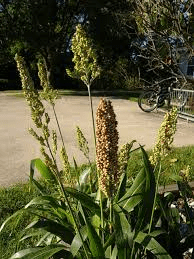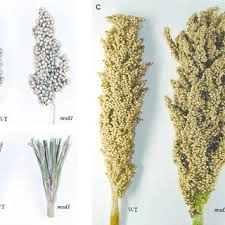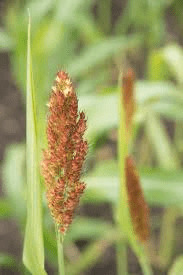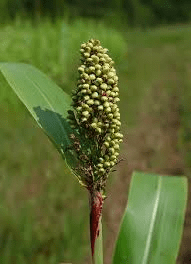Guinea Corn Inflorescence, the flowering part of Sorghum bicolor, is a crucial component of the plant’s reproductive system. It plays a vital role in the formation of grains, which are the primary economic product of the plant. The inflorescence is highly adaptable, contributing to the plant’s ability to thrive in diverse environments.
The inflorescence of Guinea corn is typically a panicle, a loose, branching cluster of flowers. This structure emerges from the top of the stem and can vary in size and shape depending on the variety and growing conditions. Panicles can be compact or open, and their branches can be short or long, affecting the overall appearance and grain yield of the plant. The adaptability of the inflorescence structure allows sorghum to be cultivated in different climates and soil types, making it a versatile crop.
Each panicle consists of numerous spikelets, which are the basic units of the inflorescence. A spikelet usually contains one or more florets, which are the individual flowers. These florets can be either fertile or sterile. The fertile florets develop into grains after pollination, while sterile florets do not. The presence of both fertile and sterile florets in the same inflorescence can influence the plant’s reproductive success and grain yield.
Pollination in Guinea corn is primarily by wind, although some varieties can self-pollinate. The flowers of sorghum are small and lack showy petals, making them well-suited for wind pollination. The anthers, which produce pollen, are exposed to the wind, allowing pollen grains to be dispersed and carried to other flowers.
The stigma, which receives the pollen, is feathery and well-adapted to catching airborne pollen grains. This efficient pollination mechanism ensures the production of grains, even in the absence of pollinators like insects.
After pollination, the florets develop into grains. The grains of Guinea corn are small, round, and can vary in color from white to yellow, red, brown, or even black, depending on the variety. These grains are rich in carbohydrates and provide a significant source of energy for both human consumption and animal feed. The grains are also used in various industrial applications, such as the production of biofuels and alcoholic beverages.
The inflorescence of Guinea corn is not only important for reproduction but also plays a role in the plant’s adaptability to environmental stresses. For instance, the timing of inflorescence emergence and flowering can be influenced by environmental factors such as temperature, day length, and water availability.
This plasticity allows sorghum to optimize its reproductive success under varying conditions. In drought-prone areas, for example, the plant may adjust its flowering time to coincide with periods of higher moisture availability, ensuring successful grain production.
Moreover, the structure of the inflorescence can affect the plant’s resistance to pests and diseases. An open panicle, for instance, may be less prone to fungal infections than a compact one, as the increased air circulation can reduce the humidity around the spikelets. Similarly, certain inflorescence traits can deter insect pests, contributing to the overall resilience of the plant.
The inflorescence of Guinea corn, predominantly in the form of a panicle, is a vital part of Sorghum bicolor’s reproductive system. It consists of numerous spikelets and florets that develop into grains after wind pollination. The adaptability of the inflorescence structure and its response to environmental factors contribute to the plant’s resilience and productivity.
Understanding the characteristics and significance of Guinea Corn Inflorescence can lead to improved cultivation practices, enhanced grain yields, and greater food security in regions where sorghum is a staple crop.
The Economic Importance and Uses of Guinea Corn Inflorescence

1. Grain Production: The inflorescence of guinea corn produces grains that are a staple food in many regions, providing essential nutrients and calories.
2. Animal Feed: The grains from the inflorescence can be used as animal feed, supplying livestock with necessary nutrients.
3. Biofuel Production: The grains can be fermented to produce bioethanol, a renewable energy source.
4. Human Consumption: The grains are used in various culinary dishes, such as porridges, bread, and beverages.
5. Traditional Medicine: The inflorescence and grains are used in traditional medicine to treat ailments such as digestive issues and inflammation.
6. Crafting Materials: The stalks of the inflorescence can be used in making crafts like baskets and brooms.
7. Erosion Control: The plants, including the inflorescence, help stabilize soil and prevent erosion.
8. Soil Fertility: The plants contribute organic matter to the soil, enhancing fertility when decomposed.
9. Green Manure: The plant residues, including the inflorescence, can be plowed back into the soil as green manure.
10. Organic Farming: The inflorescence can be used in organic farming as part of crop rotation and soil improvement strategies.
11. Biodegradable Products: Stalks and other parts of the inflorescence can be used to create biodegradable materials.
12. Craftsmanship: The stalks are used in local crafts and tools, supporting cultural heritage and providing income.
13. Renewable Energy: Besides biofuel, the biomass from the inflorescence can be used to produce biogas.
14. Animal Bedding: The stalks can be used as bedding material for livestock.
15. Nutritional Supplements: The grains can be processed into supplements rich in essential nutrients.
16. Pest Control: Residues from the inflorescence can be used to make natural pest repellents.
17. Composting: The inflorescence is excellent for composting, contributing to sustainable waste management.
18. Carbon Sequestration: The plants help in capturing carbon dioxide, aiding in climate change mitigation.
Read Also: Importance of a Sick Bay in a Ruminant House
The Products and By-products That Can Be Derived From Guinea Corn Inflorescence

1. Grain: The primary product, used for food and feed.
2. Bioethanol: Produced by fermenting the grains.
3. Animal Feed: Grains and plant residues can be used to feed livestock.
4. Traditional Medicines: Extracts from the inflorescence used in medicinal preparations.
5. Crafts: Stalks used in making baskets, brooms, and other crafts.
6. Natural Dyes: Extracts can be used to produce natural dyes for textiles.
7. Biodegradable Plastics: Inflorescence residues can be processed to create biodegradable plastics.
8. Soil Conditioner: Plant residues used to improve soil health.
9. Green Tea: The grains and plant parts can be brewed into a tea with health benefits.
10. Industrial Starch: The grains contain starch that can be used in various industrial applications.
11. Animal Bedding: Stalks used as bedding material for livestock.
12. Natural Adhesives: Extracts used to produce natural adhesives.
13. Biochar: Processed to create biochar for carbon sequestration.
14. Nutritional Supplements: Grains processed into supplements.
15. Textile Fibers: Stalks processed into fibers for textiles.
16. Bioremediation Agents: Used in products to clean contaminated soils.
17. Compost: Inflorescence residues composted to produce high-quality compost.
Read Also: Stocking Management for Ruminant Animals
Frequently Asked Questions (FAQ’s) About Guinea Corn Inflorescence

1. What is guinea corn inflorescence used for?
Guinea corn inflorescence is primarily used for grain production, which serves as a staple food and animal feed.
2. Can guinea corn inflorescence be used as animal feed?
Yes, the grains and plant residues from the inflorescence can be used to feed livestock.
3. Are there any medicinal uses of guinea corn inflorescence?
Yes, extracts from the inflorescence are used in traditional medicine for treating various ailments.
4. How does guinea corn inflorescence help in soil fertility?
When decomposed, the inflorescence adds organic matter to the soil, enhancing its fertility.
5. Can guinea corn inflorescence be used in biofuel production?
Yes, the grains can be fermented to produce bioethanol, a renewable biofuel.
6. Are guinea corn inflorescence residues useful in crafting?
Yes, the stalks can be used to make baskets, brooms, and other crafts.
7. What role does guinea corn inflorescence play in erosion control?
The plants, including the inflorescence, help stabilize soil and prevent erosion.
8. Can guinea corn inflorescence be used in composting?
Yes, the inflorescence is excellent for composting, contributing to sustainable waste management.
9. How do guinea corn inflorescence plants contribute to carbon sequestration?
The plants help capture carbon dioxide from the atmosphere, aiding in climate change mitigation.
10. Are guinea corn inflorescence products beneficial for organic farming?
Yes, the inflorescence can be used in organic farming practices, such as crop rotation and soil improvement.
Read Also: The Impact of Inefficient Waste Management on Oceans

